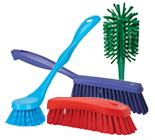Ah, the beauty and purity of a new cleaning tool. Freshly removed from any packaging, and unsullied by the elements: nothing but possibility ahead of it. Whether you enjoy opening new tools as much as I apparently do, or you are more in the “pop it open, because there is a ton of stuff to do” camp, there are a few tips that our friends from Remco have provided to get the best out of your new cleaning tool. These simple steps help to ensure safety before the first use.
New cleaning tools—especially those sealed in plastic pouches like the ones from Vikan® and Remco—often look like they’re ready for use right out of the bag. It’s easy to assume these tools can start sweeping, mopping, and brushing right away, however, as most in the food industry know, looking clean isn’t the same as actually being clean. Here are a few steps that must be taken to ensure all new tools are ready for use in food production plants:
Vikan® and Remco both apply labels directly to some of their products, as do many other cleaning tool manufacturers and distributors. Ideally, these labels will peel off easily, especially when they’re dry. If there’s a problem removing a label or there’s residual stickiness, simply use a washrag with warm water and soap, or use a sponge soaked in vinegar to remove the label and any adhesive left behind. It’s easier to peel labels when they’re dry, but a little extra effort may be needed for particularly stubborn adhesives. It’s essential to remove the label and adhesive fully, as the sticky residue can be a trap for debris and bacteria.
New tools may seem clean, but they’re produced in factory environments that do not have the same rigorous sanitation requirements as food manufacturing facilities. Put new tools through an industrial dishwasher or hand wash them, depending on what the plant’s HACCP plans call for during the tool’s regular usage. Either cleaning option may help remove any remaining label residue, along with preparing the tool for its first use. Don’t make the mistake of assuming a broom or a squeegee that will be used in a low-risk environment is “clean enough” when it comes out of the package. The tool should still be cleaned.
Decide how clean a tool should be before use, follow HACCP plans for how they’ll be cleaned during their regular usage. If a tool will be used in a high-risk environment, it should be sterilized before its first use, ensuring any microbes that may have contaminated the item before it arrived to you are fully destroyed. If a tool is going to be used in a low or medium-risk facility, simply cleaning and sanitizing the tool should be enough for it to be used safely.
No tool is clean without having been dried first. Whether by hanging it or by putting it through an industrial dishwasher’s drying cycle, tools must be dry to be considered clean. This helps prevent mold and other microorganism growth and ensures the tool is ready for use.
Once these steps are complete, the tools are ready for their designed purposes in food processing plants. Remember to maintain tools by keeping them free of debris and cleaning them frequently. Regular maintenance—starting with these first steps—will keep tools hygienic and help them last longer.
Nelson-Jameson carries a wide selection of color-coded products, including the full line of Remco products. Contact us today to learn more about the many ways Nelson-Jameson and our industry partners can help you get the tools you need on your pathway to creating safe, quality food.


December 10, 2025
What is OSHA's Regional Emphasis Program (REP) for the food manufacturing industry? The OSHA Regional Em...

December 8, 2025
There is a fundamental connection between worker safety and food safety: A failure in worker safety can ...

December 1, 2025
Nelson-Jameson understands that efficiency and worker safety are equally important goals in food manufac...